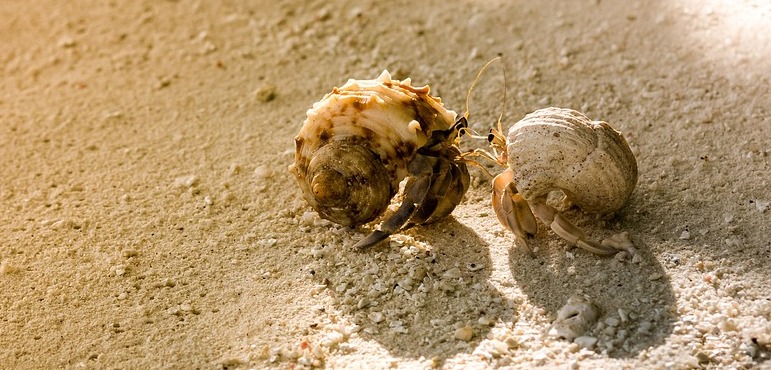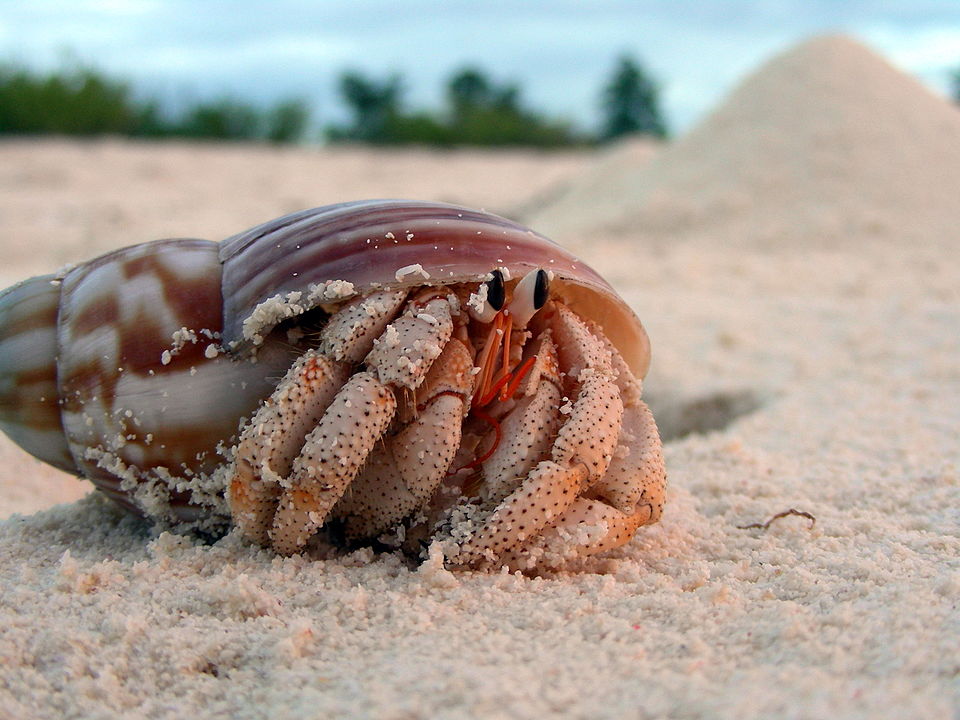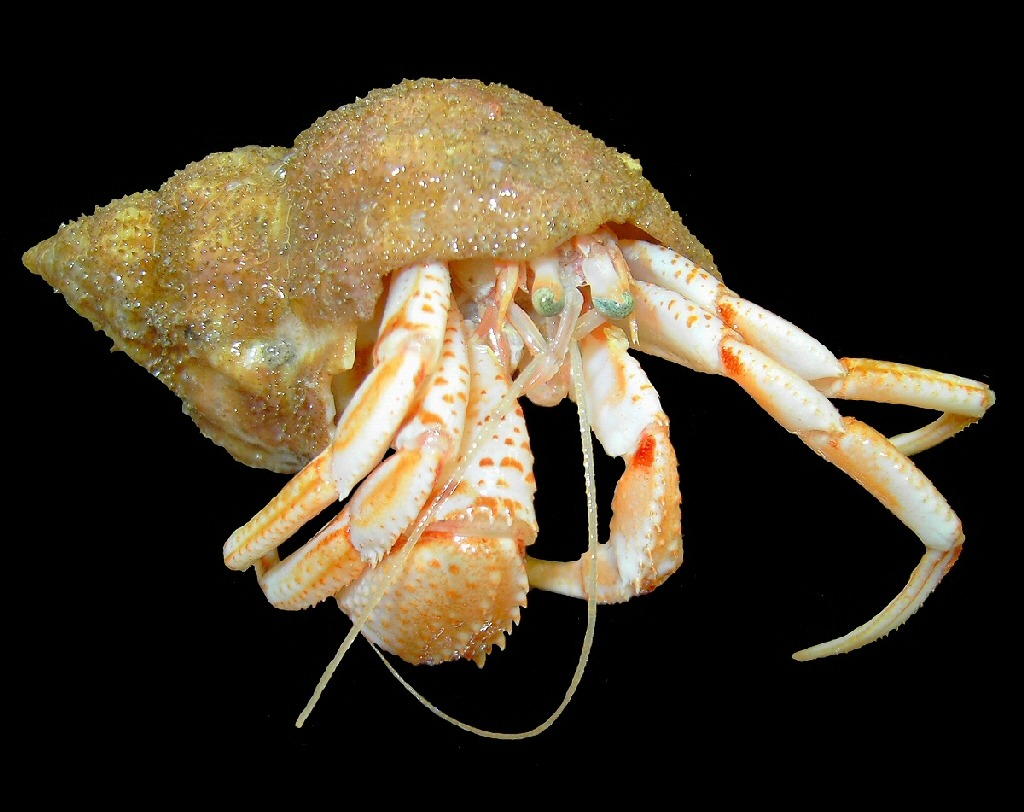Background
The Paguroidea superfamily of crustaceans includes tiny hermit crabs. Because they usually reside in abandoned snail shells, which provide as a home and protection for their fragile, spiral-shaped abdomens, they are known as “hermits.” Their distinctive appearance, which includes several pairs of legs and a hard shell covering their head and thorax, distinguishes them from other creatures.
Hermit crabs may live in both freshwater and saltwater, and they can be found in a variety of habitats, such as sandy beaches, rocky coasts, and coral reefs. Due to their omnivorous nature, they will consume a wide range of foods, including small invertebrates, fruits, and vegetables. Hermit crabs are well-liked as pets and, with the right care, can live a very long time.
History
Humans have long been interested in hermit crabs and have examined and researched them. They have been known for a very long time, and there is evidence that their shells were used as ornaments in ancient Egypt.
In the 18th and 19th centuries, hermit crabs were increasingly popular as pets in both Europe and the United States. Additionally, naturalists and scientists collected them and conducted research on them, documenting and classifying many hermit crab species.
Biological studies involving regeneration, growth, and molting, in particular, have made use of hermit crabs.
Hermit crabs gained popularity as pets during the 20th century, and several species were introduced for the pet trade from tropical areas. Since hermit crab wild numbers are declining and their natural habitats are being destroyed, questions have been raised concerning the pet trade’s ethical and environmental effects.
In general, hermit crabs have been among people for a very long time, from prehistoric times to the present. They are still a popular research topic and many people’s pet of choice.
Things that hermit crabs do to survive
Hermit crabs are relatively easy to maintain, but they do need a few things to stay healthy and happy. They need a big tank with lots of places to hide, climb, and explore. The tank should have a lid on it to keep them from escaping.
Hermit crabs require a warm environment, thus tanks should be kept between 75 and 80 degrees Fahrenheit. They also need access to both freshwater and saltwater. So that they can drink and take a bath, they should always have access to a dish of clean water. The weekly saltwater replenishment should be made with dechlorinated water and marine salt.
Hermit crabs like eating a wide variety of foods, including fruits, vegetables, fish, and commercial hermit crab food. If they eat correctly, kids will be able to stay active and healthy.
Hermit crabs thrive when kept in groups of two or more because of their gregarious nature. They frequently interact with one another by climbing on top of one another or by trading food. Keeping kids in couples or small groups will be healthier for them overall and help to reduce stress.
Owning Hermit Crabs
Hermit crabs are regarded by many people as interesting and entertaining pets. They are fascinating creatures that are easy to take care of and don’t require much maintenance. However, what knowledge is required in order to engage in hermit crab ownership? Everything you need to keep your hermit crabs healthy and happy is outlined in this article. We’ll talk about things like dietary habits, housing arrangements, and health care.
Classifications of hermit crabs
Hermit crabs are not closely connected to genuine crabs, but rather to squat lobsters and porcelain crabs (Brachyura). However, there has been much debate throughout the course of time over how king crabs and the other Paguroidea species interact. Numerous studies support the long-held theory that the king crabs in the family Lithodidae are descended from hermit crabs descended from pagurids and should be categorized as a family within Paguroidea based on their morphological traits, genetic data, and combined data.
Calcinidae
Is a superfamily of watery hermit crabs called Paguroidea.
Coenobitidae
A family of terrestrial hermit crabs that are well-known for spending their adult years on land.They are ocean-accessible and can be found in tropical coastal areas all over the world.
Diogenidae
Are a family of hermit crabs that are occasionally referred to as “left-handed hermit crabs” because, in contrast to most other hermit crabs, their left chela (claw) is enlarged rather than the right. It is the second-largest family of marine hermit crabs, after the Paguridae, with 429 current species and 46 extinct species.
Paguridae
Are members of the Decapoda family of hermit crabs. The Paguridae is a large family with 542 species spread across more than 70 genera. Some writers have assigned the king crabs, Lithodoidea, to the genus Pagurus as their ancestors.
Parapaguridae
Are a group of deep-water marine hermit crabs. Like other hermit crabs, they don’t carry empty snail shells; instead, they carry colonies of 12 or more sea urchins or zoanthids. Some genera, including Tylaspis and Bivalvopagurus, do not live in shells.
Pylochelidae
Consists of a group of hermit crabs. Members of it are frequently referred to as “symmetrical hermit crabs.” Except for the Arctic and Antarctic, they can be found in all oceans of the world at depths of 2,000 m. (6,600 ft). Only about 60 specimens had been gathered before 1987, when a book was published describing a further 400, due to their cryptic character and relative scarcity.
Pylojacquesidae
Consisting of just two species in two genera, are a small family of hermit crabs. Two specimens from the Museum für Naturkunde at the Humboldt-Universität Zu Berlin were identified as being substantially different from other hermit crabs that had been previously described, leading to the creation of the family in 2001. The family members’ mandibles are chitinous and toothed, which sets them apart from other hermit crabs.
How do I care for my hermit crabs?
To keep your hermit crab healthy and happy, you will need to provide it with a clean and comfortable home. Here are some tips on how to care for your hermit crab:
- Keep its habitat clean. This means regularly cleaning the tank and changing the water. You should also add new shells for your hermit crab to change into as it grows.
- Provide a warm and humid environment. Hermit crabs like warmth and moisture, so you will need to mist their tank regularly and provide a heat source.
- Feed them a nutritious diet. Hermit crabs are omnivores, so they need both meat and vegetables in their diet. You can buy special hermit crab food or make your own from recipes online.
Hermit crabs are low-maintenance and unique pets that can make great additions to any household. They require a habitat that mimics their natural environment, a diet that includes a variety of foods, and regular cleaning. With proper care, hermit crabs can live for several years and make great companions.
Important Things to Know
Feeding Hermit Crabs
It is advised to feed your pets at night since hermit crabs typically eat at that time in the wild. Always crush all pelleted items before feeding the crabs, and provide them a varied diet. Fruits and leafy vegetables like kale can be added to your hermit crab’s diet as a supplement. They chew their food thoroughly and consume it slowly, but any leftovers should be taken out the next morning. Last but not least, make sure they have access to clean, fresh water that is chlorine-free.
Socializing Hermit Crabs
Hermit crabs are gregarious animals that prefer to live in huge communities. As a result, if left alone for too long, they could become lonely. Getting several crabs is one way to avoid loneliness. Keep an eye out for fighting if you do add one or more hermit crabs to an existing aquarium.
Crabs may fight for a variety of reasons, such as a lack of food, water, or space. Hermit crabs can be violent toward other species and even attempt to steal shells. This kind of bullying can be avoided if there are extra shells in the tank.
Another technique to socialize and prevent loneliness in your hermit crab is to let it play outside of its container. They are peaceful creatures that both children and adults can enjoy spending time with when handled with care.
Cleaning Hermit Crabs
If you give your crabs a dish with conditioned freshwater and saltwater to bathe in, they will clean themselves. The humidity in the enclosure is increased by keeping a water sponge in the tank, which aids in keeping the species clean.
Normal Molting Behavior
Hermit crabs molt, or lose, their outer skin about twice a year. Hermit crabs that are molting become less active. Although they won’t eat much, they will consume a lot of water. It takes many weeks for their new skin to solidify, and this procedure is typical. Leave the animals alone during this period. Also, leave the shed skin in the tank; hermit crabs commonly eat it because it is a good source of calcium.
Your hermit crab will develop a new, bigger shell after molting. A few should be prepared so they can select the most appropriate one. Hermit crabs go through a constant, cyclical process of growth, skin shedding, and shell change.
Signs of Health Problems
Stress and poisoning are the two most typical medical conditions that affect pet hermit crabs. A stressed crab will become inactive, and slow, and may leave its shell for an extended period (without taking another one, like it does when molting). Aggression, extremely cold or hot conditions, loneliness, or overcrowding can all cause stress in hermit crabs.
If hermit crabs are accidentally misted with water-containing chemicals, poisoning may result. Hermit crabs that have been poisoned will abandon their shells and refuse to eat more. Consult a veterinarian who specializes in the treatment of hermit crabs if either of these behavioral patterns occurs.
Conclusion
For those looking for a special, low-maintenance pet, keeping hermit crabs can be a pleasant and gratifying experience. It’s important to provide them with a home that closely replicates their native habitat, complete with a tank with a lid, a source of heat and humidity, and a variety of hiding spots. The health and well-being of the hermit crabs depend on regular cleaning and upkeep of their home.







